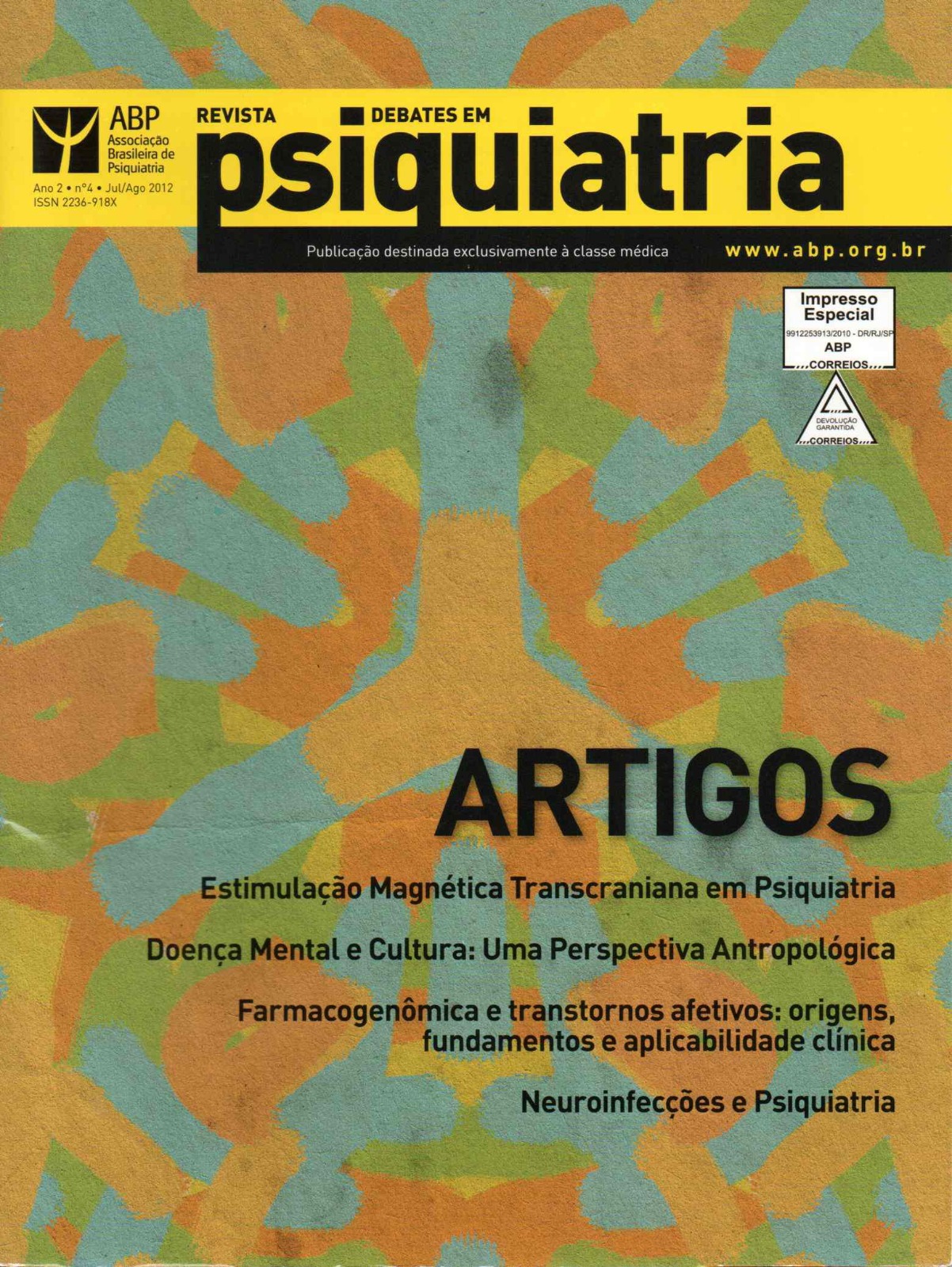Neuroinfecciones y psiquiatría
DOI:
https://doi.org/10.25118/2763-9037.2012.v2.890Palabras clave:
neuroinfecciones, virus Nipah, Bornavirus, trastornos mentales y del comportamiento, trastornos mentalesResumen
Los trastornos psiquiátricos graves no tienen una causa definida, dada la peculiar complejidad de la formación de los síntomas mentales y su sensibilidad a los efectos mínimos sobre el flujo de neurotransmisores en las vías neuronales. En este trabajo abordamos las neuroinfecciones en su ámbito general, neuropatológico y, en particular, como posible origen de la enfermedad mental como causa primaria. En este particular, presentamos evidencia epidemiológica que sugiere un modelo infeccioso de trastorno afectivo, implicando a los virus Nipah y Borna como una de las causas probables de enfermedad mental.
Descargas
Métricas
Citas
Lishman WA. Organic Psychiatry: The Psychological Consequences of Cerebral Disorder, Oxford: Blackwell Scientific, 1998.
Lashley FR. Emerging infectious diseases: vulnerabilities, contributing factors and approaches. Expert review of anti--infective therapy, 2004;2: 299–316.
Ferreira MLM, Cavalcanti CG, Coelho CA, Mesquita SD. Neurological manifestations of dengue: study of 41 cases, Arq. Neuro-Psiquiatr. 2005; 63: 488-93.
Gubler DJ, Kuno G, Watermen SH. Neurologic disorders associated with dengue infection. International conference on dengue/dengue haemorrhagic fever. Kuala Lumpur, 1983.
Hendarto SK, Hadinegoro SR. Dengue encephalopathy. Acta Paediatr Jpn 1992;34: 350-7.
Braga MDM, Alcântara GC, Silva CN, Nascimento CGH. Cerebral Malaria in Ceará: a case report, Rev. Soc. Bras. Med. Trop. 2004; 37: 53-5.
Idro R, Ndiritu M, Ogutu B, Mithwani S, Maitland K, et al. Burden, features, and outcome of neurological involvement in acute falciparum malaria in Kenyan children. JAMA 2007; 297: 2232–40.
Schofield L, Grau GE. Immunological processes in malaria pathogenesis. Nat Rev Immunol 2005; 5: 722–35.
Renard, E. Le docteur Gaëtan Gatian de Clérambault – Sa vie et son oeuvre (1872-1934), Paris: Les Empêcheurs de Penser en Rond, 1992.
Swedo SE, Leonard HL, Mittleman BB, Allen AJ, Rapoport JL, Dow SP, et al. Identification of children with pediatric autoimmune neuropsychiatric disorders associated with streptococcal infections by a marker associated with rheumatic fever. Am J Psychiatry 1997;154:110-2.
Swedo SE, Leonard HL, Rapoport JL. The pediatric autoimmune neuropsychiatric disorders associated with streptococcal infection (PANDAS) subgroup: separating fact from fiction. Pediatrics, 2004; 113: 907-11.
Teixeira AL, Corrêa H, Cardoso F, Fontenelle LF. Síndromes neuropsiquiátricas pós-estreptocócicas, J. Bras. Psiquiatr., 2006; 55: 62-9.
Torrey EF, Yolken RH. Toxoplasma gondii and schizophrenia, Emerging Infectious Diseases, 2003; 9: 1375-80.
Webster JP, Lamberton PHL, Donnelly CA, Torrey EF. Parasitescausative agents of human affective disorders? The impact of anti-psychotic, mood-stabilizer and anti-parasite medication on Toxoplasma gondii’s ability to alter host behavior, Proc. R. Soc. B, 2006; 273: 1023-30.
Mesa-Castilo, S. Estúdio ultraestructural do lóbulo temporal y de la sangre periférica en pacientes esquizofrénicos, Revista de Neurologia, 2001; 33:619-23.
Brown AB, Hooton J, Schaefer CA, Zhang H, Petkova E, Babulas V et al. Elevated maternal interleukin-8 levels and risk of schizophrenia in adult offspring, Am J Psychiatry 2004; 161:889–95.
Babulas V, Factor-Litvak P, Goetz R, Schaefer CA, Brown AS. Prenatal exposure to maternal genital and reproductive infections and adult schizophrenia, Am J Psychiatry 2006; 163:927–29.
Mumford C, Dudley N, Terry H. Leptospirosis presenting as a flaccid paraplegia. Postgrad Med J 1990; 66:218-20.
Faine S. Leptospira and Leptospirosis, Boca Ratón: CRC Press, 1994.
Sacktor N, McDermott MP, Marder K, Schitto G, Selnes OA, McArthur JG et al. HIV-associated cognitive impairment before and after the advent of combination therapy, J. NeuroVirol. 2002; 8:136-42.
Ellis R, Langford D, Masliah E. HIV and antiretroviral therapy in the brain: neuronal injury and repair. Nat Rev Neurosci 2007; 8: 33–44.
Jayawardena S, Singh S, Burzyantseva O, Clarke H. Cerebral Toxoplasmosis in Adult Patients with HIV Infection, 2008 (July): 17-24.
Burgos JM, Begher S, Silva HM, Bisio M, Duffy T. et al. Case report: Molecular identification of Trypanosoma cruzi I tropism for central nervous system in Chagas reactivation due to AIDS. Am J Trop Med Hyg 2008; 78: 294–297.
Akpan N, Caradonna K, Chuenkova MV, Pereiraperrin M. Chagas’ disease parasite-dereived neurotrophic factor activates cholinergic gene expression in neuronal PC12 cells. Brain Res, 2008; 1217: 195–202.
Epstein JH, Field HE, Luby S, Pulliam JR, Daszak P. Nipah virus: impact, origins, and causes of emergence. Curr Infect Dis Rep 2006; 8: 59–65.
Goh KJ, Tan CT, Chew NK, et al. Clinical features of Nipah virus encephalitis among pig farmers in Malaysia, N. Engl J. Med., 2000; 342: 1229-35.27. Eaton BT, Broder CC, Middleton D, Wang LF. Hendra and Nipah viruses: different and dangerous. Nat Rev Microbiol. 2006; 4: 23-35.
Chua KB, Goh KJ, Wong KT, et al. Fatal encephalitis due to the Nipah virus among pig farmers in Malaysia, The Lancet, 1999; 354: 1257-59.
Chua KB, Tan CT, Hooi PS, et al. High mortality in Nipah encephalitis is associated with presence of virus in cerebrospinal fluid, Ann. Neurol., 2000; 48: 802-5.
Cheyette SR, Cummings JL. Encephalitis lethargica: lessons for contemporary neuropsychiatry. J. Neuropsychiatry Clin. Neurosci 1995; 7: 125-34.
Lim CC, Sitoh YY, Hui F, et al. Nipah virus encephalitis or Japanese encephalitis? MR findings in an new zoonótica disease, AJNR Am. J. Neuroradiol. 2000; 21: 455-61.
Lim CC, Lee KE, Lee WE, et al. Nipah virus encephalitis: serial MR study of an emerging disease, Radiology 2002; 222:219-26.
Beng-Yeong N, Lim CCT, Yeoh A, Lee WL. Neuropsychiatric sequelae of Nipah virus encephalitis, J. Neuropsychiatry Clin. Neurosci. 2004; 16: 500-4.
Ackermann A, Staeheli P, Schneider U. Adaptation of Borna disease virus to new host species attributed to altered regulation of viral polymerase activity, J. Virol. 2007; 81: 7933–40.
Waltrip RW, Buchanan RW, Carpenter WT, et al. (February 1997). Borna disease virus antibodies and the deficit syndrome of schizophrenia. Schizophr. Res. 1997; 23: 253–7.
Chen CH, Chiu YL, Weif FC, et al. High seroprevalence of Borna virus infection in schizophrenic patients, family members and mental health workers in Taiwan. Molecular psychiatry, 1999; 4: 33-8.
Amsterdam JD, Winokur A, Dyson W, et al. Borna disease virus: A possible etiologic factor in human affective disorders?, Archives of General Psychiatry, 1985; 42:1093-6.
VandeWoude S, Richt JA, Zink MC, Rott R, Narayan O, Clements JE. A borna virus cDNA encoding a protein recognized by antibodies in humans with behavioral diseases. Science 1990; 250: 1278-81.
Rott R, Herzog S, Bechter K, Frese K. “Borna disease, a possible hazard for man?”. Archives of Virology 1991; 118: 143-9
Bode L. Human infections with Borna disease virus andpotential pathogenic implications, Current Topics in Microbiology and Immunology, 1995; 190:103-30.
Bode L, Reckwald P, Severus WE, Stoyloff R, Ferszt R, Dietrich DE, Ludwig H. Borna disease virus-specific circulating immune complexes, antigenemia, and free antibodies - the key marker triplet determining infection and prevailing in severe mood disorders. Mol. Psychiatr. 2001; 6: 481-91.
Bode L, Ludwig H. Borna disease virus infection, a human-mental risk. Clinical Microbiology Reviews, 2003; 16: 534-45.
Miranda HC, Nunes SO, Calvo ES, Suzart S, Itano EN, Watanabe MA. Detection of Borna disease virus p24 in peripherical blood cells from Brazilian mood and psychotic disorder patients. J Affect Disord 2006; 90: 43–7.
Dietrich DE, Bode L, Spannhuth CW, et al. Amantadine in depressive patients with Borna disease virus (BDV) infection:an open trial. Bipolar Disord. 2000; 2: 65–70.
Horsman Y. Interferon-induced depression in chronic hepatitis C. Journal of Antimicrobial Chemotherapy 2006;58:711-13.
Câmara, FP. Epidemiologia para psiquiatras, Propsiq – Programa de atualização em psiquiatria, Porto Alegre: Artmed/Panamericana Ed., 2012; 2 (ciclo 1): 9-39.
World Health Organization. The global burden of disease (2012) in: http://www.who.int/features/factfiles/global_burden/facts/en/index6.html [acessado em 07.04.2012]
Descargas
Publicado
Cómo citar
Número
Sección
Licencia
Derechos de autor 2012 Fernando Portela Câmara

Esta obra está bajo una licencia internacional Creative Commons Atribución-NoComercial 4.0.
Debates em Psiquiatria permite que el (los) autor (es) mantenga(n) sus derechos de autor sin restricciones. Permite al (los) autor (es) conservar sus derechos de publicación sin restricciones. Los autores deben garantizar que el artículo es un trabajo original sin fabricación, fraude o plagio; no infringe ningún derecho de autor o derecho de propiedad de terceros. Los autores también deben garantizar que cada uno atendió a los requisitos de autoría conforme a la recomendación del ICMJE y entienden que, si el artículo o parte de él es fallido o fraudulento, cada autor comparte la responsabilidad.
Reconocimiento-NoComercial 4.0 internacional (CC BY-NC 4.0) - Debates em Psiquiatria es regida por la licencia CC-BY-NC
Usted es libre de:
- Compartir — copiar y redistribuir el material en cualquier medio o formato
- Adaptar — remezclar, transformar y crear a partir del material
El licenciador no puede revocar estas libertades mientras cumpla con los términos de la licencia. Bajo las condiciones siguientes:
- Reconocimiento — Debe reconocer adecuadamente la autoría, proporcionar un enlace a la licencia e indicar si se han realizado cambios<. Puede hacerlo de cualquier manera razonable, pero no de una manera que sugiera que tiene el apoyo del licenciador o lo recibe por el uso que hace.
- NoComercial — No puede utilizar el material para una finalidad comercial.
No hay restricciones adicionales — No puede aplicar términos legales o medidas tecnológicas que legalmente restrinjan realizar aquello que la licencia permite.






























